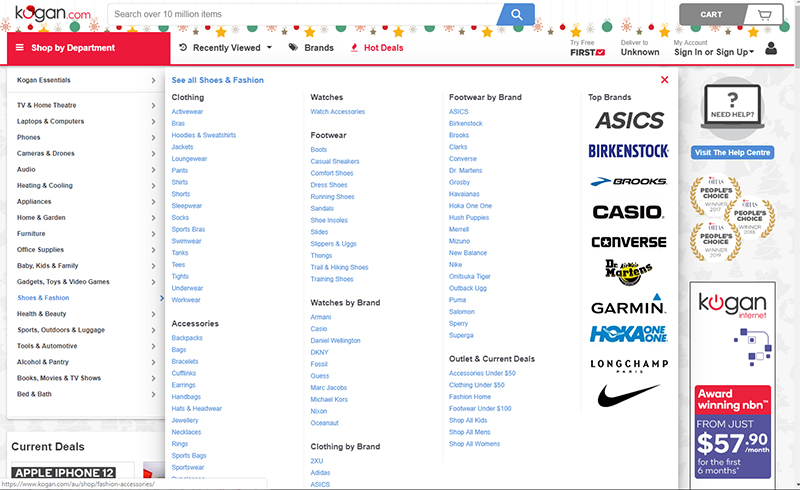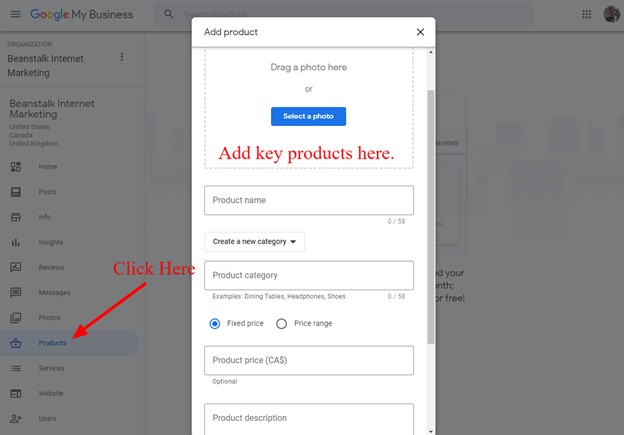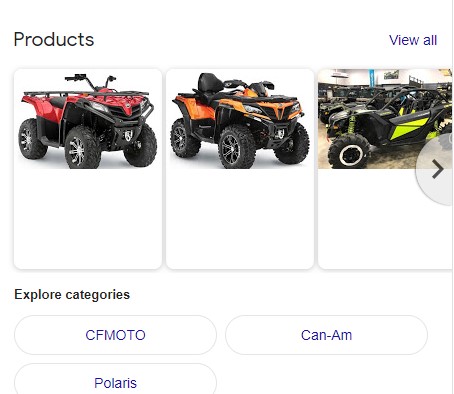28 Oct 5 SEO Quick Fixes for Ecommerce Sites via @oohloo
Many things in SEO are hard.
Many things are time-consuming.
But not all of them.
In fact, there are some issues we see all the time – especially in ecommerce SEO.
What follows are five of the most common SEO problems that have quick fixes.
SEO Quick Fix 1: Nav Links
By far the number one issue I encounter is in the navigation.
The lion’s share of ecommerce sites fall into one of two categories:
Mega Mega Mega Menu
Menus can get out of hand when people use the approach of “fewest clicks,” as opposed to “least amount of time to complete a task.”
Site owners know where things are – and so, a system like this:


It may be incredibly helpful if you know exactly where you’re going unless the link you want is one that doesn’t even fit on the screen.
Users aside, this structure basically assigns the same PageRank/internal link weight to every single category and sub-category.
It’s important to remember that if your page has 100% of its weight to pass, if you divide it over 10 links, each link gets 10% of the weight.
And if you link to 263 pages as this site is, each one is getting 0.38%.
So, find the top categories and pages that you want to rank, and push the weight there.
After all, imagine if Amazon did that.
And I hear they may have a decent SEO professional or two, on staff.
Lack of Direction
One that leaves me scratching my head every time is when there’s no logical structure to the nav, and often not even the pages to rank.
As an SEO professional, I’m left wondering what conversation led to the building of a powersports website with no link to “ATVs” (literally happened yesterday, as of this writing).
What’s perplexing is if I ask the owner, “What do you want to sell?”, they’d say “ATVs.”
And if I ask them to get to it on their site they’ll generally have to head to a product page and start messing around with filters.
Leading to the questions:
- What page example should rank for ATVs?
- Why do you hate your visitors so much?
Often, I believe it’s simply poor or rushed design and a lack of understanding from the business owner.
The lack of understanding is fully acceptable.
I don’t know ATVs, they don’t know design and SEO.
But the poor or rushed design is unacceptable.
Designers aren’t SEO pros.
That’s not my beef – and I’m a crappy designer.
But they are there to help users get where they need to go.
And a poorly developed navigation is a sign of a lack of understanding on the part of the designer in how to complete that task.
Perhaps a new profession is in order?
The Fix?
The fix in both cases is the same.
Consider what products and services you most want to sell, and get them into the navigation in a clear way.
Think about what pages need the link weight most to rank.
And what structure will get the user from your homepage to their product as quickly as possible if they’re a casual surfer who doesn’t know offhand the location of sub-sub-sub-category X.
And when in doubt, visit Amazon or other sites that rank well in your niche.
Flatter them with your imitation.
SEO Quick Fix 2: Schema
Ecommerce sites tend to be missing product schema, organizational schema, or both.
I can’t stress enough how important they are.
- Organizational schema to help reinforce who, what, and where you are.
- Product schema to reinforce that you sell stuff, assisting not just in product queries themselves, but more generalized “buy terms.”
Adding schema to your site can be easy or complex, depending on how your website CMS functions.
If you’re in WordPress, it’s fairly straightforward to get the basics in.
But it can be onerous to get the more advanced functionality to really set yourself apart.
Regardless of the system, for organizational I personally tend to ignore the plugins/add-ons, etc., and go straight to the source(code).
I use a tool like Merkle’s Schema Markup Generator to get a head start on the schema basics and then go to the Organization area of Schema.org to refine and add as much relevant data as I can.
The more specific you can be, the less possible confusion there will be for the engines.
If you have access to the templates you can just add this into the header.
If you don’t and you’re not using a system like WordPress that has plugins that allow you to add code into the header and footer, you can add it into Google Tag Manager as custom HTML and simply set it to appear on all pages.
Product schema is a little more finicky, and unless you have either a handful of products or an expanse of time, you’ll need to automate how it’s created as it’s a per-product thing.
Systems like Shopify, WooCommerce, etc. will do this for you.
But if you’re in a system that doesn’t, you’ll need to work with your developers.
I can’t stress how important this is in ecommerce.
Increased visibility for products:


And increased rankings for purchase intent, general queries by clarifying that you’re not just talking about products, you sell them, you have them, and they’re in stock.
(Or not per the example above, but these days that rowing machine is hard to get your hands on… and so I wait.)
While working with your dev, or troubleshooting/setting up plugins may not seem like a quick fix but it is.
You will be literally improving, to a serious degree, every product page on your site.
Yes, it might take more than a few minutes, but by the end – on a per-page/product level it’ll probably be mere seconds.
And that’s pretty quick.
SEO Quick Fix 3: Product Titles
This one makes it on so many of my lists because it’s so easy and so overlooked.
Most ecommerce systems come with a pre-configured setup for how titles are created – that business owners rarely revisit.
And those that don’t, come with configuration options and can almost always be easily adjusted in the code.
Let’s take for example a system that formats the product titles (slight adjustment to company name to not violate privacy):
“2021 Ford Shelby Mustang GT350 Red, White, Silver, Blue, Black Now In Stock | Beanstalk Cars”
This is not a random example, I took very strong inspiration from a site I was reviewing earlier today.
And this is one of the first areas I’d address.
In a SERP that becomes:
“2021 Ford Shelby Mustang GT350 Red, White, Silver, Blue,…”
Neither awesome for users, nor SEO-friendly.
In the code it was basically:
<vehicle> <colors> Now In Stock | Beanstalk Cars
The code simply needs to be changed to something like:
<vehicle> In Stock | Company Name
So, the same product would now appear as:
“2021 Ford Shelby Mustang GT350 In Stock | Beanstalk Cars”
Not 100% of the titles work, but based on our crawl data about 93% would, as opposed to 57% prior to the switch.
And in many cases, it also simply chops off “cars,” meaning the real meat of the title is intact.
The benefits are two-fold:
Improved CTR
Better, cleaner and more easily read titles get higher click-throughs.
We’ve seen them range from just a few percent increases, to up to 3x depending on how poorly they started.
But consider the number of pages impacted and even a few percent is huge.
Improved Rankings
Focused titles, focused SEO.
Chopping out the less or irrelevant verbiage increases the overall relevance of the title to what the page is actually about – the 2021 Ford Shelby Mustang.
Once more you may need to contact your dev if you don’t control this or know how to code, and you might say…my individual product pages only get on average 20 entrances per year.
Fair point.
And if we increased that by only 5%, that’s a lot of work for 1 visitor.
But you probably don’t have just one product.
The site I was looking at had about 6,000 products.
Let’s say only 10% of them are performers to the 20 entrances per year level.
That’s still an extra 600 visitors.
Plus, improved SEO to add to that traffic.
Suddenly it seems worth sending that email to your dev, doesn’t it?
Because I’m guessing you’ll pay more than the cost of making that edit to get 600 visitors consistently per year via PPC.
Or even just improving the rankings in other areas to facilitate that type of improvement.
SEO Quick Fix 4: Featured Snippets
If you find yourself ranking decently but not wonderfully for queries, it might be time to pursue featured snippets.
It doesn’t apply in all cases, but it applies in many.
In many cases you can look at queries you rank on page one for but not in the top three, first consider if there is a featured snippet to take, and if not, ask “Should there be?”
I’ve been testing timelines, done right it takes about 3 weeks.
If a query has a possible intent that can be summarized in 300 characters or less or in a list, then it’s yours to take if you just come up with a better answer for the user’s intent than currently exists.
In one of my more recent efforts, we wanted to take the snippet from someone else.
They had an older page with a good answer.
We edited a newer page to include a clear section:
Heading tag – What is a <subject>?
With about a 250-character definition, that includes keywords that we knew would be relevant to a good answer.
As noted, in just under 3 weeks we took the featured snippet.
It’s generally a faster path to the top position than slogging through link building.
You just need to produce superior content in a format (and voice) that fits Position Zero.
I’d suggest starting in Search Console and visit your top queries where you are in position four to ten.
Figure out which have someone else holding the featured snippet and produce a better answer, clearly structured.
If there is no featured snippet, consider whether there should be and test making them.
Want to rank for “blue widgets?”
Adding a section “What Are Blue Widgets?” with a 295 character definition might be a great place to start.
Or perhaps a list “Types (or uses) of Blue Widgets.”
Or perhaps both.
Hedge your bets.
SEO Quick Fix 5: Google My Business Products
One of my big favorite hidden gems is the product listing in Google My Business.
When you log in you simply head over to:


And voila! Your knowledge panel comes up.


I like to keep my eye on the stats and so I use UTM codes in the URLs like:
https://www.sampledomain.com/product/?utm_source=google&utm_medium=organic&utm_campaign=GMBproducts
(You can get as elaborate as you like.)
Then I can easily find it in my analytics and see how they convert.
Interestingly, in a lot of cases, people buy different products than they click on.
Thankfully, I’m most interested in that they spent money and how much – and generally less on what they bought.
This is one of the fastest areas to complete and needs little-to-no technical skill.
Just pick the products you want to promote and get started.
In Closing
Even if you aren’t highly skilled in code, and you don’t have time for major undertakings, there’s almost always something you can do.
Hopefully, these five SEO quick fixes for ecommerce sites gives you a place to start.
But not a place to end.
More Resources:
- A Guide to On-Page SEO for Ecommerce Websites
- 5 Ecommerce SEO Tips to Improve Organic Performance
- Ecommerce Marketing: The Definitive Guide
Image Credits
Featured Image: Adobe Stock
All screenshots taken by author, October 2020
Sorry, the comment form is closed at this time.